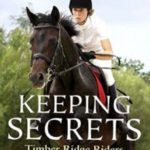I need advice for my daughter and her horse. My daughter is 10 years old and very interested in riding, however she lacks confidence in riding. Her horse has come to figure this out. Cheyenne is a very sweet and gentle horse and a tab bit on the lazy side. I would like to find out information or suggestions on how to teach my daughter to win her horse’s respect and have him respond to her commands. When she asks him to walk he refuses. He cocks his back leg and stands there no matter what she does .Also once she does get him to move he begins to pull her in the wrong direction and when she tries to bring him back he resists her. When I ride him he does perfectly. What can I do to help her? She is very frustrated and so am I.
ANSWER: Horses are herd animals and the social structure within the herd is known as a “linear hierarchy.” The definition of a linear hierarchy is that each individual in the herd is either subordinate to or dominant over every other individual in the herd. Since this is the only way that horses know to act, it is also how they relate to their human herd members. We need to think of the horse and its rider as a herd of two. So we have a choice, we can either be the dominant member (or the leader) or the subordinate member (the follower). There is no equality in a horse herd.

Clearly, in the case of your daughter’s horse, she is subordinate to the horse, while you are dominant over the horse. The horse has already made up his mind that this is the way it is and there have probably been countless little things that has lead the horse to this conclusion. So how do we change this? Well, I can think of a few options.
Only your daughter will be able to step forward and take the leadership role with her horse. You riding the horse will not affect the relationship between horse and daughter, as clearly the horse does not question your authority. I do not recommend that your daughter take an aggressive approach (do this or else), because in the situation where the rider has a history of being subordinate, a challenge could prompt the horse to be fractious and start bucking or worse. Instead, your daughter needs to get inside the horse’s mind and learn to control ALL of his actions.
First, your daughter will need to make up her mind to resolve this situation and accept the fact that it may take some time. She will need to have a assertive, but patient attitude. I recommend that she address the issue of respect on the ground first. She needs to have a sense of awareness of her horse and she must take control of every move he makes. That means, when he is tied to the hitch rail, he should stand exactly where she told him to. If he steps sideways or back or forward, she should gently but firmly put his feet exactly back in the spot that she first asked him to stand. The horse should learn to respect her space and yield to it. She should be able to walk, trot and halt the horse at halter, back him up and disengage his hindquarters (make him cross his hind legs). All of these are examples of controlling the horse’s space and when the horse does these things without question, he is respecting her leadership authority. Disengaging the hindquarters is really important both on the ground and mounted, because it forces the horse into a subordinate frame of mind. When his hind legs are crossed, his number one line of defense (flight) is taken away from him, so subconsciously he becomes more dependent.
Your daughter must learn to only ask what she can enforce and ALWAYS enforce what she asked the horse to do. So for now, that probably means backing up and enforcing her control in areas where she can be successful. So often, I see people ask something of their horse, lets say to turn right, and the horse resists and refuses, so the rider caves in and lets the horse turn left. The rider thinks that she is winning because she got the horse where she wanted it by circling it all the way around to the left. But the horse sees it differently. He does not have the capability to realize that the rider got him where she wanted anyway. All the horse knows is that he didn’t want to turn right, he wanted to go left and if he refuses, the rider will cave into his wishes. To us humans, these little battles seem unimportant, but to the horse, the littlest things have big meaning.
Every time the horse gets his way, he scores a point and is further convinced in his mind that he is in charge. It sounds like your daughter’s horse has scored a lot of points. What your daughter will have to understand and commit to is that she has a lot of points to score, before she pulls ahead. She needs to realize that the tiniest things count toward this score: the horse moving around at the hitching rail, not trotting on the lead line, the horse taking a step toward the person, the horse nudging the person with his head, taking one step off the rail in the arena, or not going when asked. The rider that is dominant and in control is the one that controls every movement the horse makes. The more she can make this horse yield to her, the more points she will score. But start small and build up to the big issues. If she can gain some respect from the ground, it may be a little easier for her.
To address the specific problem in the arena, your daughter should look for the areas that she is still in control and focus on those and reward the horse when he responds. If the horse is balking, the issue is to get his feet moving. Usually the easiest way to do this is to turn him in a tight circle (this has the added advantage of disengaging the hindquarters). Be sure to reward him when he responds (even if he responds reluctantly) and immediately take control of the situation. How? As soon as she gets the horse to move, she should ask him to stop. Why? By doing this she has accomplished two things: she has rewarded his response by asking him to stop (which is what he wanted to do), but more importantly she has taken control by issuing a command and getting a response. It does not matter that the horse wanted to stop anyway, because he stopped on her request, not his. By successfully getting a response to a command, she puts the horse in a responsive frame of mind. So, she will get the horse to move (by turning a tight circle if she has to) and once the horse has taken a few steps, ask him to stop and reward him with a pat on the neck and leaving him alone for a few minutes, then ask again. Initially, when the horse had responded a few times, find a good stopping point and put him away. Gradually build on what she asks the horse to do.
It is critical that once she has asked something of the horse that she insists upon his response. This does not mean that you kick or hit harder and harder, but that you continue to apply the aids until the horse responds. Sometimes children do not have the strength to keep legging the horse until he moves and the horse learns that the rider will get tired and give up before he does. If this is the case, she might need a stick or spurs. HOWEVER, use these artificial aids with caution because this could drive the dominant horse to more drastic and fractious responses. Whatever aids she is using to make the horse go (and it should be all of the aids), she should continue to apply them until the horse goes. Not necessarily harder and harder, but with persistence. Eventually, the horse will learn that the only way to make that annoying action go away is to move forward.
A couple of more thoughts, if you or your daughter feed treats to this horse, stop immediately. Chances are, the horse has become demanding and rude and this has contributed to his dominance. When horses are subordinate (whether to you or another herd member), they will always yield to the space of the dominant individual. When people feed treats, the horse learns to move into the space of the person and thus you are yielding to his space, therefore he is dominant. Every treat that is fed, reinforces his dominance.
And now having said that, I have one more thought that seemingly contradicts what I just said. There is a form of training called “clicker training” that is being used on horses although it was originally developed to train marine mammals. It uses a clicking device as reinforcement and the first step is to make the horse associate the clicker with positive reinforcement (grain). Then, just like in Pavlov’s Response, every time the horse hears the clicker, he associates it with good thoughts (grain) and knows he is doing the right thing. I have seen this training method used specifically in the same situation that your daughter is in, with good success. So it might be worth looking into. You would have to do the clicker training and then would be able to use the clicker to control the horse’s mind while your daughter is up. The clicker and grain reinforcer just gives the horse a different motivation for doing the right thing.
My personal preference would be for your daughter to establish herself as the leader of their herd of two by doing the groundwork and gaining her horse’s respect. But the clicker method might be worth looking into.








